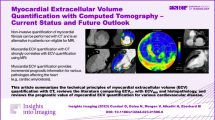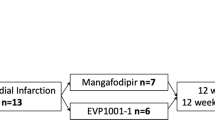Abstract
Background
Quantitative cardiac contractile function assessment is the primary indicator of disease progression and therapeutic efficacy in small animals. Operator dependency is a major challenge with commonly used echocardiography. Simultaneous assessment of cardiac perfusion and function in nuclear scans would reduce burden on the animal and facilitate longitudinal studies. We evaluated the accuracy of contractile function measurements obtained from electrocardiogram-gated nuclear perfusion imaging compared with anatomic imaging.
Methods and Results
In healthy C57Bl/6N mice (n = 11), 99mTc-sestamibi SPECT and 13N-ammonia PET underestimated left ventricular volumes (23 to 28%, P = 0.02) compared to matched anatomic images, though ejection fraction (LVEF) was comparable (%, SPECT: 73 ± 8 vs CMR: 72 ± 6, P = 0.1). At 1 week after myocardial infarction (n = 13), LV volumes were significantly lower in perfusion images compared to CMR and contrast CT (P = 0.003), and LVEF was modestly overestimated (%, SPECT: 37 ± 8, vs CMR: 27 ± 7, P = 0.003). Nuclear images exhibited good intra- and inter-reader agreement. Perfusion SPECT accurately calculated infarct size compared to histology (r = 0.95, P < 0.001).
Conclusions
Cardiac function can be calculated by gated nuclear perfusion imaging in healthy mice. After infarction, perfusion imaging overestimates LVEF, which should be considered for comparison to other modalities. Combined functional and infarct size analysis may optimize imaging protocols and reduce anaesthesia duration for longitudinal studies.






Similar content being viewed by others
Abbreviations
- CMR:
-
Cardiac magnetic resonance
- CT:
-
Computed tomography
- ECG:
-
Electrocardiography
- LVEF:
-
Left ventricular ejection fraction
- MI:
-
Myocardial infarction
- PBS:
-
Phosphate-buffered saline
- PET:
-
Positron emission tomography
- ROI:
-
Region of interest
- SPECT:
-
Single-photon emission-computed tomography
- VOI:
-
Volume of interest
References
Collins KA, Korcarz CE, Lang RM. Use of echocardiography for the phenotypic assessment of genetically altered mice. Physiol Genomics 2003;13:227-39.
Stypmann J, Engelen MA, Troatz C, Rothenburger M, Eckardt L, Tiemann K. Echocardiographic assessment of global left ventricular function in mice. Lab Anim 2009;43:127-37.
Wiesmann F, Ruff J, Dienesch C, et al. Cardiovascular phenotype characterization in mice by high resolution magnetic resonance imaging. MAGMA 2000;11:10-5.
Amundsen BH, Ericsson M, Seland JG, Pavlin T, Ellingsen O, Brekken C. A comparison of retrospectively self-gated magnetic resonance imaging and high-frequency echocardiography for characterization of left ventricular function in mice. Lab Anim 2011;45:31-7.
Prunier F, Marescaux L, Franconi F, et al. Serial magnetic resonance imaging based assessment of the early effects of an ACE inhibitor on postinfarction left ventricular remodeling in rats. Can J Physiol Pharmacol 2005;83:1109-15.
Wiesmann F, Ruff J, Engelhardt S, et al. Dobutamine-stress magnetic resonance microimaging in mice: Acute changes of cardiac geometry and function in normal and failing murine hearts. Circ Res 2001;88:563-9.
Weiss RG. Imaging the murine cardiovascular system with magnetic resonance. Circ Res 2001;88:550-1.
Pai RG, Varadarajan P. Echocardiography and cardiovascular magnetic resonance: Evolution as complementary imaging tools. Curr Cardiol Rep 2006;8:155-7.
Nahrendorf M, Badea C, Hedlund LW, et al. High-resolution imaging of murine myocardial infarction with delayed-enhancement cine micro-CT. Am J Physiol Heart Circ Physiol 2007;292:H3172-8.
Badea CT, Bucholz E, Hedlund LW, Rockman HA, Johnson GA. Imaging methods for morphological and functional phenoty** of the rodent heart. Toxicol Pathol 2006;34:111-7.
Lusic H, Grinstaff MW. X-ray-computed tomography contrast agents. Chem Rev 2013;113:1641-66.
Constantinesco A, Choquet P, Goetz C, Monassier L. PET, SPECT, CT, and MRI in mouse cardiac phenoty**: An overview. Curr Protoc Mouse Biol 2012;2:129-44.
Constantinesco A, Choquet P, Monassier L, Israel-Jost V, Mertz L. Assessment of left ventricular perfusion, volumes, and motion in mice using pinhole gated SPECT. J Nucl Med 2005;46:1005-11.
Befera NT, Badea CT, Johnson GA. Comparison of 4D-microSPECT and microCT for murine cardiac function. Mol Imaging Biol 2014;16:235-45.
Hendrikx G, Bauwens M, Wierts R, Mottaghy FM, Post MJ. Left ventricular function measurements in a mouse myocardial infarction model. Comparison between 3D-echocardiography and ECG-gated SPECT. Nuklearmedizin 2016;55:115-22.
Thackeray JT, Bankstahl JP, Wang Y, et al. Targeting post-infarct inflammation by PET imaging: Comparison of (68)Ga-citrate and (68)Ga-DOTATATE with (18)F-FDG in a mouse model. Eur J Nucl Med Mol Imaging 2015;42:317-27.
Thackeray JT, Derlin T, Haghikia A, et al. Molecular imaging of the chemokine receptor CXCR4 after acute myocardial infarction. JACC Cardiovasc Imaging 2015;8:1417-26.
Thackeray JT, Bankstahl JP, Wang Y, Wollert KC, Bengel FM. Targeting amino acid metabolism for molecular imaging of inflammation early after myocardial infarction. Theranostics 2016;6:1768-79.
Heiberg E, Sjogren J, Ugander M, Carlsson M, Engblom H, Arheden H. Design and validation of Segment–freely available software for cardiovascular image analysis. BMC Med Imaging 2010;10:1.
Sherif HM, Saraste A, Weidl E, et al. Evaluation of a novel (18)F-labeled positron-emission tomography perfusion tracer for the assessment of myocardial infarct size in rats. Circ Cardiovasc Imaging 2009;2:77-84.
Wollenweber T, Zach C, Rischpler C, et al. Myocardial perfusion imaging is feasible for infarct size quantification in mice using a clinical single-photon emission computed tomography system equipped with pinhole collimators. Mol Imaging Biol 2010;12:427-34.
Mannheim JG, Schlichthaerle T, Kuebler L, et al. Comparison of small animal CT contrast agents. Contrast Media Mol Imaging 2016;11:272-84.
Gao XM, Dart AM, Dewar E, Jennings G, Du XJ. Serial echocardiographic assessment of left ventricular dimensions and function after myocardial infarction in mice. Cardiovasc Res 2000;45:330-8.
Constantinescu CC, Mukherjee J. Performance evaluation of an Inveon PET preclinical scanner. Phys Med Biol 2009;54:2885-99.
Bao Q, Newport D, Chen M, Stout DB, Chatziioannou AF. Performance evaluation of the inveon dedicated PET preclinical tomograph based on the NEMA NU-4 standards. J Nucl Med 2009;50:401-8.
Stegger L, Heijman E, Schafers KP, Nicolay K, Schafers MA, Strijkers GJ. Quantification of left ventricular volumes and ejection fraction in mice using PET, compared with MRI. J Nucl Med 2009;50:132-8.
Champion C, Le Loirec C. Positron follow-up in liquid water: II. Spatial and energetic study for the most important radioisotopes used in PET. Phys Med Biol 2007;52:6605-25.
Huisman MC, Higuchi T, Reder S, et al. Initial characterization of an 18F-labeled myocardial perfusion tracer. J Nucl Med 2008;49:630-6.
Berman DS, Maddahi J, Tamarappoo BK, et al. Phase II safety and clinical comparison with single-photon emission computed tomography myocardial perfusion imaging for detection of coronary artery disease: Flurpiridaz F 18 positron emission tomography. J Am Coll Cardiol 2013;61:469-77.
Williams RV, Lorenz JN, Witt SA, Hellard DT, Khoury PR, Kimball TR. End-systolic stress-velocity and pressure-dimension relationships by transthoracic echocardiography in mice. Am J Physiol 1998;274:H1828-35.
Stuckey DJ, Carr CA, Tyler DJ, Clarke K. Cine-MRI versus two-dimensional echocardiography to measure in vivo left ventricular function in rat heart. NMR Biomed 2008;21:765-72.
Verberne HJ, Acampa W, Anagnostopoulos C, et al. EANM procedural guidelines for radionuclide myocardial perfusion imaging with SPECT and SPECT/CT: 2015 revision. Eur J Nucl Med Mol Imaging 2015;42:1929-40.
Lim M, Wang W, Liang L, et al. Intravenous injection of allogeneic umbilical cord-derived multipotent mesenchymal stromal cells reduces the infarct area and ameliorates cardiac function in a porcine model of acute myocardial infarction. Stem Cell Res Ther 2018;9:129.
Lugomirski P, Chow BJ, Ruddy TD. Impact of SPECT myocardial perfusion imaging on cardiac care. Expert Rev Cardiovasc Ther 2014;12:1247-9.
Acknowledgements
This study was partly supported by the German Research Foundation (DFG, Clinical Research Group KFO311, Excellence Cluster REBIRTH-2, and Grant-in-aid TH2161/1-1). The authors thank the Preclinical Molecular Imaging and Radiochemistry Laboratories (Nuclear Medicine), the Small Animal MRI Centre (Central Animal Facility) and the Molecular and Translational Cardiology Laboratory (Department of Cardiology and Angiology) for their assistance.
Disclosures
All authors declare that they have no conflict of interest.
Author information
Authors and Affiliations
Corresponding author
Additional information
Publisher's Note
Springer Nature remains neutral with regard to jurisdictional claims in published maps and institutional affiliations.
The authors of this article have provided a PowerPoint file, available for download at SpringerLink, which summarises the contents of the paper and is free for re-use at meetings and presentations. Search for the article DOI on SpringerLink.com.
Electronic supplementary material
Below is the link to the electronic supplementary material.
Rights and permissions
About this article
Cite this article
Hess, A., Nekolla, S.G., Meier, M. et al. Accuracy of cardiac functional parameters measured from gated radionuclide myocardial perfusion imaging in mice. J. Nucl. Cardiol. 27, 1317–1327 (2020). https://doi.org/10.1007/s12350-019-01713-z
Received:
Accepted:
Published:
Issue Date:
DOI: https://doi.org/10.1007/s12350-019-01713-z




